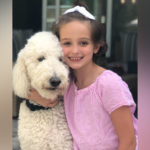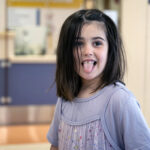Seeds of hope for Annie: one family’s story of epilepsy care

Ten-year-old Annie Dinan experienced her first noticeable seizure just before her fourth birthday while riding in the car with her family.
“I had never seen a seizure in my entire life,” her mom, Lindsay, says of witnessing Annie lose then quickly regain consciousness. “But somehow, I knew exactly what it was.”
Refusing to settle
Following her seizure, doctors in Annie’s home state of New Jersey discovered a large malformation on the left frontal lobe of her brain — the area that controls certain motor functions as well as language. Brain malformations are a result of part of the brain being abnormally large or small, inadequately developed, or missing.
Annie’s care team diagnosed her seizures as characteristic of epilepsy, a brain disorder that causes reoccurring seizures.
The news came as a surprise to Lindsay and her husband, Tim.
“We were totally shocked,” Lindsay says. “Her development up until then had been completely normal; she hadn’t had any sort of speech delay or other cause for concern.”
Even though Annie’s care team followed her closely, she experienced spontaneous seizures for years — most often in her sleep — and medication to combat the seizures wasn’t effective.
Taking bold steps
Lindsay and Tim grew frustrated with Annie’s inconclusive testing and what they felt was a lack of treatment plan, so they decided to expand their options.
“This is not good enough,” Lindsay remembers thinking. “We need to do better.”
Lindsay and Tim brought Annie to specialists in Philadelphia. They loved the care and attention Annie received, but they were hesitant about her proposed treatment plan: to surgically remove the entire left frontal lobe of her brain.
“We worried that it was too aggressive of a decision to make without conclusive data on whether or not the surgery would affect her language and motor ability,” Lindsay says.
A family friend suggested contacting Dr. Annapurna Poduri, a pediatric neurologist and director of the Neurogenetics and Epilepsy Genetics programs at Boston Children’s Hospital. Soon after speaking with Dr. Poduri’s team, the family made the nearly five-hour drive to Boston.
Informing their decision
At Boston Children’s, Annie, Lindsay, and Tim met with not only Dr. Poduri but also with Dr. Jeffrey Bolton, Dr. Scellig Stone, and others from the Epilepsy Center.
The team agreed that surgery was a bold first step. They encouraged Lindsay and Tim to take time to decide, and discussed options for the interim.
While we always had wonderful people helping us, there’s no comparison to the care we received at at Boston Children’s. It was over the top.
– Lindsay Dinan, Annie’s mom
Dr. Stone suggested stereoelectroencephalography (sEEG) to monitor activity in Annie’s left frontal lobe. The results of the sEEG would guide if and how to approach surgery to stop her seizures.
Electroencephalograms measure electrical activity in the brain and help detect potential neurological problems. While conventional EEGs last less than an hour, sEEG is a surgery to implant brain electrodes that then remain in place for a week.
Because Annie’s seizures had been so erratic, Lindsay and Tim worried that the procedure wouldn’t produce useful enough information to justify surgery.
“We spent years wavering about a surgery that could either be really detrimental or really helpful and never knowing which it was going to be,” Lindsay says. “We never thought we’d get to a point where we could make a decision.”
Planting the seeds for answers
When Annie’s seizures became more frequent and more intense about a year ago, and additional testing confirmed that her malformation did not impact the language-controlling or motor-coordinating portions of her brain, Lindsay and Tim decided to pursue surgery.
The Boston Children’s team was ready.
Last fall, Dr. Stone implanted 17 sEEG electrodes to monitor Annie’s brain activity. The electrodes captured multiple seizures in her left frontal lobe.
A week later, he removed the electrodes and performed a left frontal lobe resection/disconnection. The procedure cuts the nerve pathways in the brain that seizure impulses travel through.
Getting back on the run
In the months since her surgery, Annie has been seizure-free. Today, she’s enjoying Girl Scouts, piano lessons, and being part of Girls on the Run — an organization that promotes self-confidence in young girls through life-skills lessons and running.
Lindsay and Tim are thrilled to see Annie more like her old self, and are incredibly grateful to Drs. Bolton and Stone for helping Annie regain a sense of normalcy while being kind and respectful of the family’s feelings, concerns, and faith.
“Dr. Bolton has really been on this journey with us, and we wouldn’t have gotten through it without him,” Lindsay says. “We are incredibly blessed to have had his support and guidance through it all.”
“And Dr. Stone is not only a very skilled surgeon, but is very human and easy to talk to,” she adds. “He talked us through everything as though he was our friend. You’re putting so much trust in these people,” Lindsay says, “and these two dynamic doctors made it so easy to do. They made us feel so comfortable.”
Learn more about how the Epilepsy Center at Boston Children’s helps evaluate, treat, and counsel children with epilepsy and seizures.
Related Posts :
-

Fighting for answers: Innovative approach to epilepsy helps Emma thrive
As a nurse, Lynda Coto was used to solving problems — until she was faced with her own daughter’s ...
-

I tried the keto diet to help my epilepsy and it changed my life
My name is Dennis. I’m 15 years old and live in East Greenwich, Rhode Island. Two years ago, I started ...
-

Diving deep on epilepsy genetics
When child neurologist Annapurna Poduri, MD, MPH finished her clinical epilepsy fellowship at Boston Children’s Hospital in 2004, she was ...
-

“Princess June” reigns supreme over Rasmussen syndrome
What do you call a “girly” 5-year-old who adores dolls and frilly nightgowns? If you’re one of June Pelletier’...





